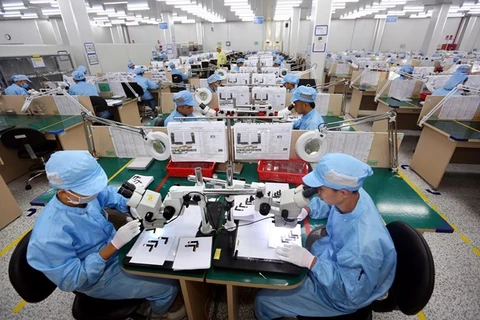Hanoi (VNA) – The imbalance in labour demand and supply between regions and economic sectors requires suitable reallocation of labour resources to boost growth.
Labour imbalance
Vietnam’s labour market has seen certain improvements in recent years but there remain many problems, heard a workshop in Hanoi on April 26.
Held by the Central Institute for Economic Management (CIEM) and the Australian-supported Restructuring for a more competitive Vietnam (Aus4Reform) programme, the workshop featured discussions on the development of the labour market to promote economic restructuring in the country.
According to Le Thi Xuan Quynh, Deputy Director of the Sector Economic Research Department at the CIEM, the country’s workforce has been shifting from agriculture to industry and services, and from the information sector to the formal one.
 The workshop is held by the Central Institute for Economic Management (CIEM) and the Australian-supported Restructuring for a more competitive Vietnam (Aus4Reform) programme. (Photo: VietnamPlus)
The workshop is held by the Central Institute for Economic Management (CIEM) and the Australian-supported Restructuring for a more competitive Vietnam (Aus4Reform) programme. (Photo: VietnamPlus) Quynh, however, also pointed to limitations regarding legal documents and policies, notably the labour imbalance between regions and economic sectors, citing a report by the CIEM in 2020 showing the number of trained labourers accounted for only 24.5 percent of the total.
Currently, the quality of Vietnam’s labour resources was still very low, reaching only 46 out of 100 points, ranking the 103rd in the world and far behind the ASEAN-4 group, she said, adding the country’s vocational education and training sector was equipping learners with fundamental theoretical knowledge but lacking in skills related to specific occupations.
Consolidating labour-related institutions, policies
Deputy Director of CIEM Tran Kim Chung said economic restructuring is among the Party and State’s major policies to renew the growth model and improve the competitiveness of Vietnam’s economy.
One of the most important aspects of economic restructuring is to gradually shift from growth based on an increased quantity of inputs for production to one based on improved workplace productivity and quality, the application of science and technology, and innovation.
To do that, Vietnam must further distribute production resources, including human resources, to sectors with stronger competitiveness, higher productivity, and more substantial contributions to economic development, Chung went on.
He noted that the labour market has seen certain improvements through favourable policies and legal framework for development, increasing workplace quality and competitiveness and creating jobs.
According to CIEM researchers, workers have shifted from agriculture to the industrial and service sectors, from the informal sector to the formal one, from unstable jobs (self-employment, unpaid family labour) to more stable, sustainable, and secure jobs, from simple occupations to highly skilled ones, and from low-productivity sectors to others with higher productivity.
Workers' awareness of social and unemployment insurance has also improved greatly, and the proportion of those taking part in voluntary social and unemployment insurance grown considerably.
However, the CIEM study also pointed out a number of problems in Vietnam’s labour market, including legal documents and policies being yet to cover all parties, workforce redundancies, low employment quality, and a serious imbalance in labour supply and demand between regions and economic sectors.
While informal and unskilled labour still accounts for the majority, intermediate institutions and welfare and insurance policies remain weak and ineffective, the study found.
Chung held that to boost the labour market in the time ahead, it is necessary to refine regulations and policies on human resources training, job creation, and wages, while developing intermediate institutions, welfare mechanisms, and social insurance for workers, for a modern and effective labour market to come into being.
Nguyen Tu Anh, an official from the Party Central Committee’s Economic Commission, said the wage policy should be amended in tandem with the development of intermediate institutions, welfare mechanisms, and social insurance, to promote a modern and effective labour market integrated into the regional and global labour markets, thereby helping with economic restructuring./.























